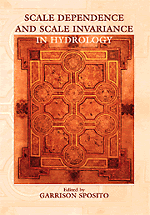Book contents
- Frontmatter
- Contents
- List of Contributors
- Preface
- 1 Scale Analyses for Land-Surface Hydrology
- 2 Hillslopes, Channels, and Landscape Scale
- 3 Scaling in River Networks
- 4 Spatial Variability and Scale Invariance in Hydrologic Regionalization
- 5 An Emerging Technology for Scaling Field Soil-Water Behavior
- 6 Scaling Invariance and the Richards Equation
- 7 Scaling of the Richards Equation and Its Application to Watershed Modeling
- 8 Scale Issues of Heterogeneity in Vadose-Zone Hydrology
- 9 Stochastic Modeling of Scale-dependent Macrodispersion in the Vadose Zone
- 10 Dilution of Nonreactive Solutes in Heterogeneous Porous Media
- 11 Analysis of Scale Effects in Large-Scale Solute-Transport Models
- 12 Scale Effects in Fluid Flow through Fractured Geologic Media
- 13 Correlation, Flow, and Transport in Multiscale Permeability Fields
- 14 Conditional Simulation of Geologic Media with Evolving Scales of Heterogeneity
- Index
12 - Scale Effects in Fluid Flow through Fractured Geologic Media
Published online by Cambridge University Press: 18 January 2010
- Frontmatter
- Contents
- List of Contributors
- Preface
- 1 Scale Analyses for Land-Surface Hydrology
- 2 Hillslopes, Channels, and Landscape Scale
- 3 Scaling in River Networks
- 4 Spatial Variability and Scale Invariance in Hydrologic Regionalization
- 5 An Emerging Technology for Scaling Field Soil-Water Behavior
- 6 Scaling Invariance and the Richards Equation
- 7 Scaling of the Richards Equation and Its Application to Watershed Modeling
- 8 Scale Issues of Heterogeneity in Vadose-Zone Hydrology
- 9 Stochastic Modeling of Scale-dependent Macrodispersion in the Vadose Zone
- 10 Dilution of Nonreactive Solutes in Heterogeneous Porous Media
- 11 Analysis of Scale Effects in Large-Scale Solute-Transport Models
- 12 Scale Effects in Fluid Flow through Fractured Geologic Media
- 13 Correlation, Flow, and Transport in Multiscale Permeability Fields
- 14 Conditional Simulation of Geologic Media with Evolving Scales of Heterogeneity
- Index
Summary
Introduction
Fractures result from mechanical breaks in intact geologic media such as rocks or compacted glacial tills. Although a fracture that is completely filled by minerals is still considered a fracture in the geologic sense, within the context of subsurface fluid flow we think of a fracture as a mechanical break that results in void space between the fracture walls. This void space is more or less planar – one of its dimensions (the aperture or distance between fracture walls) is much smaller than the other two (the extension of the fracture plane). When interconnected, fractures provide pathways for fluid flow through geologic media that would be significantly less permeable if the media were unfractured.
The geometry of subsurface fractures varies greatly, with fracture lengths ranging from less than a millimeter (e.g., a microcrack in a rock grain) to thousands of kilometers (e.g., a fault along a tectonic-plate boundary). Fracture apertures vary from minute “hairline” cracks, nearly imperceptible to the naked eye, to solution-enlarged channels wide enough for human exploration. Fractures can be highly interconnected in a densely fractured rock, or isolated and poorly connected in a sparsely fractured rock. Some fracture networks exhibit a nested pattern, with smaller fractures bounded by larger ones (Barton and Hsieh, 1989). Studies of the processes that create fractures over this broad range of scales constitute an active area of research in the earth sciences.
In a study of fragmentation, Turcotte (1986) found that the fragmentation process often results in a power-law or fractal distribution of fragment sizes.
- Type
- Chapter
- Information
- Scale Dependence and Scale Invariance in Hydrology , pp. 335 - 353Publisher: Cambridge University PressPrint publication year: 1998
- 37
- Cited by



